
Concept explainers
(a)
Interpretation:
The structure from the given IUPAC name with appropriate stereochemistry is to be drawn.
Concept introduction:
The root name in the given IUPAC name suggests the main chain or ring of carbon atoms in the compound. The suffix to root name indicates the highest priority
The stereochemical designation and the locators are enclosed in parenthesis at the very beginning of the name. The stereochemistry at the chiral center is determined by assigning the priorities to the groups attached to the chiral center on the basis of
Answer to Problem E.48P
The structure for IUPAC name
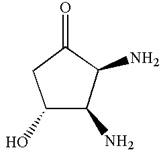
Explanation of Solution
The given IUPAC name is
The root name in this IUPAC name ‘cyclopentan’ represents the main ring of five carbon atoms. The suffix ‘one’ represents the highest priority functional group -
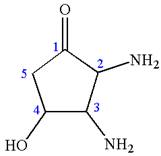
The structure has three chiral centers,
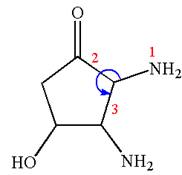
Thus, for absolute configuration
The absolute configuration at
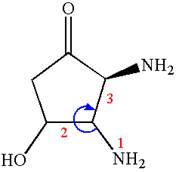
Thus, for absolute configuration
The absolute configuration at
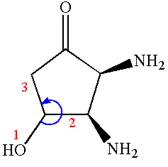
Thus for absolute configuration
Hence, the structure for is
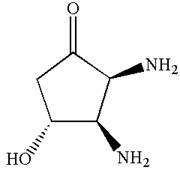
The structure for the given IUPAC name is drawn by identifying the highest priority functional group from the suffix, main chain from root name, and the position for the substituents from the locant with appropriate stereochemistry.
(b)
Interpretation:
The structure from the given IUPAC name with appropriate stereochemistry is to be drawn.
Concept introduction:
The root name in the given IUPAC name suggests the main chain or ring of carbon atoms in the compound. The suffix to root name indicates the highest priority functional group. The prefix with locant number indicates the number of substituents and their respective position at the main chain or at a ring of carbon atoms.
The stereochemical designation and the locators are enclosed in parenthesis at the very beginning of the name. The stereochemistry at the chiral center is determined by assigning the priorities to the groups attached to chiral center on the basis of atomic number of directly bonded atom. If the sequence of priority order
Answer to Problem E.48P
The structure for IUPAC name
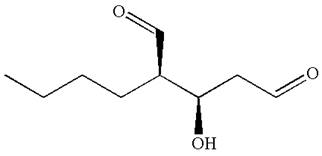
Explanation of Solution
The given IUPAC name is
The root name in this IUPAC name ‘pentane’ represents the main chain of five carbon atoms. The suffix ‘dial’ represents the highest priority functional group
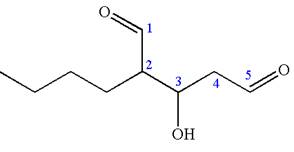
The structure has two chiral centers,
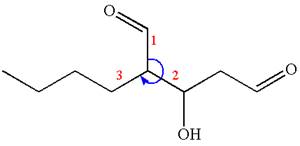
Thus, for the absolute configuration
The absolute configuration at
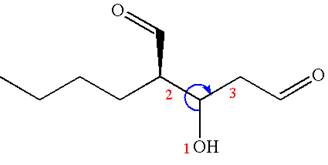
Thus for the absolute configuration
Hence, the structure for
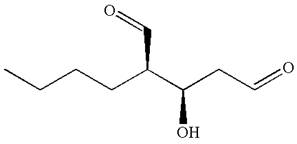
The structure for the given IUPAC name is drawn by identifying the highest priority functional group from the suffix, main chain from root name, and the position for the substituents from the locant with appropriate stereochemistry.
(c)
Interpretation:
The structure from the given IUPAC name with appropriate stereochemistry is to be drawn.
Concept introduction:
The root name in the given IUPAC name suggests the main chain or ring of carbon atoms in the compound. The suffix to root name indicates the highest priority functional group. The prefix with locant number indicates the number of substituents and their respective position at the main chain or at a ring of carbon atoms.
The stereochemical designation and the locators are enclosed in parenthesis at the very beginning of the name. The stereochemistry at the chiral center is determined by assigning the priorities to the groups attached to chiral center on the basis of atomic number of directly bonded atom. If the sequence of priority order
Answer to Problem E.48P
The structure for IUPAC name
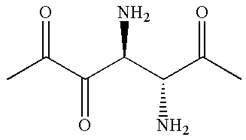
Explanation of Solution
The given IUPAC name is
The root name in this IUPAC name ‘heptane’ represents the main chain of seven carbon atoms. The suffix ‘
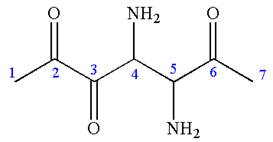
The structure has two chiral centers,
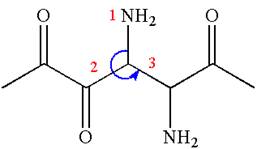
Thus, for the absolute configuration
The absolute configuration at
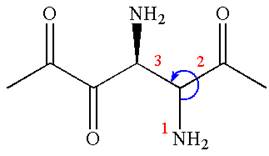
Thus, for the absolute configuration
Hence, the structure for

The structure for the given IUPAC name is drawn by identifying the highest priority functional group from the suffix, main chain from root name and the position for the substituents from the locant with appropriate stereochemistry.
(d)
Interpretation:
The structure from the given IUPAC name with appropriate stereochemistry is to be drawn.
Concept introduction:
The root name in the given IUPAC name suggests the main chain or ring of carbon atoms in the compound. The suffix to root name indicates the highest priority functional group. The prefix with locant number indicates the number of substituents and their respective position at the main chain or at a ring of carbon atoms.
The stereochemical designation and the locators are enclosed in parenthesis at the very beginning of the name. The stereochemistry at the chiral center is determined by assigning the priorities to the groups attached to chiral center on the basis of atomic number of directly bonded atom. If the sequence of priority order
Answer to Problem E.48P
The structure for IUPAC name
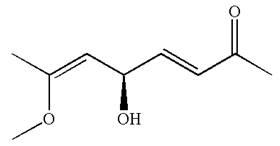
Explanation of Solution
The given IUPAC name is
The root name in this IUPAC name ‘octa’ represents the main chain of eight carbon atoms. The suffix ‘
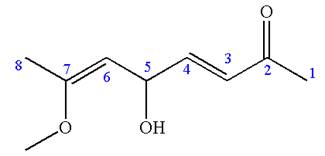
The structure has one chiral center,
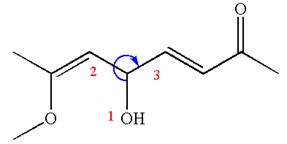
Thus for the absolute configuration
Hence, the structure for
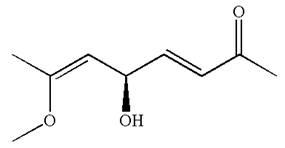
The structure for the given IUPAC name is drawn by identifying the highest priority functional group from the suffix, main chain from root name and the position for the substituents from the locant with appropriate stereochemistry.
Want to see more full solutions like this?
Chapter E Solutions
Organic Chemistry: Principles and Mechanisms (Second Edition)
- help 20arrow_forwardProvide the drawing of the unknown structure that corresponds with this data.arrow_forward20.44 The Diels-Alder reaction is not limited to making six-membered rings with only car- bon atoms. Predict the products of the following reactions that produce rings with atoms other than carbon in them. OCCH OCCH H (b) CH C(CH₂)s COOCH མ་ནས་བ (c) N=C H -0.X- (e) H C=N COOCHS + CH2=CHCH₂ →→arrow_forward
- 3) Draw a detailed mechanism and predict the product of the reaction shown? 1) EtMgBr 2) H3O+arrow_forwardHow to draw the mechanism for this reaction?arrow_forward> H₂C=C-CH2-CH3 B. H₂O Pt C. + H2 + H₂O H D. 16. Give the IUPAC name for each of the following: B. Cl Cl c. Cl Cl 17. Draw the line-angle formula for each of the following compounds: 1. phenol 2. 1,3-dichlorobenzene 3. 4-ethyltoluene < Previous Submit Assignment Next ▸arrow_forward
 ChemistryChemistryISBN:9781305957404Author:Steven S. Zumdahl, Susan A. Zumdahl, Donald J. DeCostePublisher:Cengage Learning
ChemistryChemistryISBN:9781305957404Author:Steven S. Zumdahl, Susan A. Zumdahl, Donald J. DeCostePublisher:Cengage Learning ChemistryChemistryISBN:9781259911156Author:Raymond Chang Dr., Jason Overby ProfessorPublisher:McGraw-Hill Education
ChemistryChemistryISBN:9781259911156Author:Raymond Chang Dr., Jason Overby ProfessorPublisher:McGraw-Hill Education Principles of Instrumental AnalysisChemistryISBN:9781305577213Author:Douglas A. Skoog, F. James Holler, Stanley R. CrouchPublisher:Cengage Learning
Principles of Instrumental AnalysisChemistryISBN:9781305577213Author:Douglas A. Skoog, F. James Holler, Stanley R. CrouchPublisher:Cengage Learning Organic ChemistryChemistryISBN:9780078021558Author:Janice Gorzynski Smith Dr.Publisher:McGraw-Hill Education
Organic ChemistryChemistryISBN:9780078021558Author:Janice Gorzynski Smith Dr.Publisher:McGraw-Hill Education Chemistry: Principles and ReactionsChemistryISBN:9781305079373Author:William L. Masterton, Cecile N. HurleyPublisher:Cengage Learning
Chemistry: Principles and ReactionsChemistryISBN:9781305079373Author:William L. Masterton, Cecile N. HurleyPublisher:Cengage Learning Elementary Principles of Chemical Processes, Bind...ChemistryISBN:9781118431221Author:Richard M. Felder, Ronald W. Rousseau, Lisa G. BullardPublisher:WILEY
Elementary Principles of Chemical Processes, Bind...ChemistryISBN:9781118431221Author:Richard M. Felder, Ronald W. Rousseau, Lisa G. BullardPublisher:WILEY





